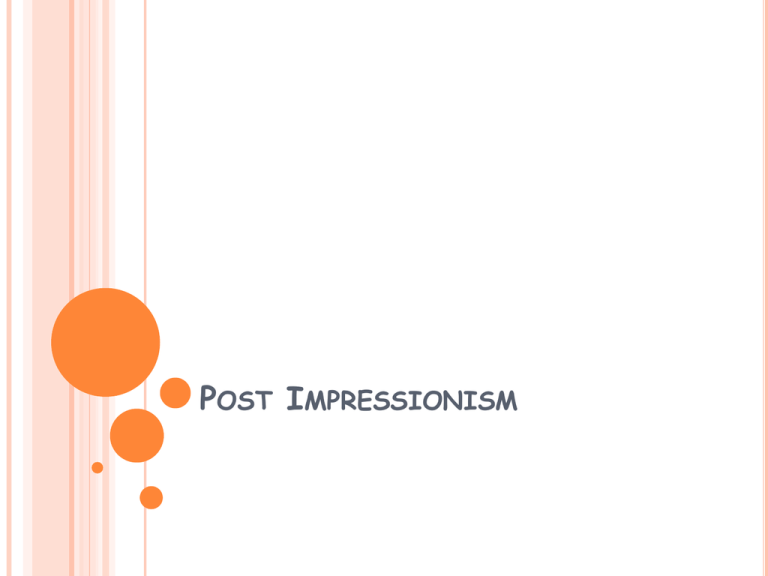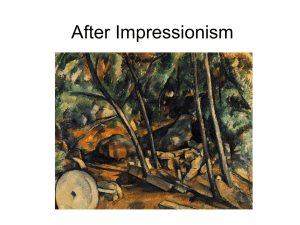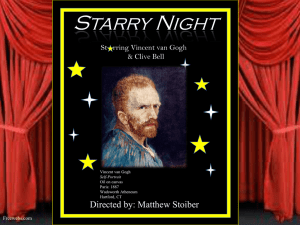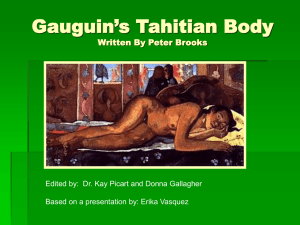Post Impressionism - Art Teachers` Association of Ireland
advertisement

POST IMPRESSIONISM POST-IMPRESSIONISM As Impressionism became more accepted and admired, a new generation of artists , although initially influenced by the work of the Impressionists , gradually became dissatisfied with their singleminded desire to capture the fleeting moments of light conditions. They wanted to re-establish some of the art elements and compositional structure in their paintings, which the Impressionists had considered unimportant. Although they worked theses traditional elements into their paintings , they didn’t always use them in conventional ways. Backgrounds were sometimes painted in an abstract manner with colour , line and pattern used to create an atmosphere in the picture instead of simply representing the actual reality of the scene. Different viewpoints were also used to create interesting and innovative compositions. The Post-Impressionists were never a formal group or movement, even though some worked in close proximity with each other. Each artist was very individual in style and technique, their outlooks on life and in their subject matter , even though they were all united in their desire to explore colour, line, pattern and form in their work. MOST INFLUENTIAL : POST-IMPRESSIONISM Paul Cezanne (1839-1906) Paul Gauguin (1848-1903) Vincent van Gogh (1853-1890) George Seurat – Neo Impressionism (1859- 1891) Date: 1848-1903 Cities: Paris, Peru, Panama, Martinique, Brittany, Tahiti, The Marquesas. Movement: Post-ImpressionismSynthetism. Influenced by: Impressionists, Cezanne and Emile Bernard. Influenced : Van Gogh, Symbolist movement. Themes: France and Tahiti, peasant life in Brittany. Style: Vibrant colours and strong outlines. PAUL GAUGUIN PAUL GAUGUIN LIFE AND WORK Gauguin was born in Paris in 1848, moved to Peru at the age of three for 4 years ,with his family. Aged 17 he began a career in the French merchant marines. In 1870, aged 22 he took a job as a stockbroker and marries Mette Sophie Gad, a Danish girl. At aged 35 Gauguin quits his successful job as a successful stockbroker and becomes a full time artist, exhibiting work with the Impressionists and taking lessons from Pissarro. Gauguin is reduced to poverty , leading to the breakdown of his marriage. His wife returned to Denmark with their 5 children. In 1887 he travelled to Panama and Martinique for inspiration, coming back with vivid and exciting work. He continued his quest for a more simplistic and natural way of life in trips to Brittany in Northern France, where he painted the local people and the landscape in bold bright colours with heavily delineated outlines . He was joined on a trip to Arles in Southern France by Vincent Van Gogh. Although Gauguin has become recognised in Parisian circles as an inspirational painter, he was still impoverished. In 1891 Gauguin moved to Tahiti in French Polynesia to immerse himself into ‘primitive’ society, unmarred by western civilisation. There he produced some of his best and most famous works, although he had frequent problems with the colonial authorities and the Catholic Church. He returned to Paris for two years in 1893 to exhibit his work. Dreaming of fame and success, his hopes were dashed and he again departed Paris for Tahiti. His health had begun to deteriorate, making it difficult to paint regularly. In 1901 Gauguin settled in the Marquesas islands in French Polynesia, again had problems with the local authorities. While appealing against a libel charge he suffered a stroke and died. The Vision after the Sermon ,1888 by Paul Gauguin SPOT THE DIFFERENCE (THERE ARE 6) What is the name of this painting? Who painted it? In what year? SPOT THE DIFFERENCE (THERE ARE 6) What is the name of this painting? Who painted it? In what year? THE VISION AFTER THE SERMON ,1888 BY PAUL GAUGUIN This painting is also known as ‘Jacob Wrestling with the angel. Painted in Brittany. Subject matterAnti-naturalistic and based on a vision these peasant women had on their way home after a sermon in their church of Jacob wrestling the angel. Composition- The women who form a curve on the lower left of the painting make a continuous line by their white caps and dark dresses (traditional Bretons costume). This is counter-balanced by the strong diagonal of the tree trunk, with it’s leaves leading the viewer to the upper right corner of the canvas as it creates a frame for the focal point of the painting namely the women’s vision The congregation appear large at the forefront of the picture space looking on the scene in devout prayer, creating the illusion that we are apart of the group witnessing the vision over the heads of the figures in front. THE VISION AFTER THE SERMON ,1888 BY PAUL GAUGUIN Gauguin does not adopt the realistic approach to composition, preferring to distort the scene to reflect the impact such an apparition would have. He has no interest in creating realistic 3-Dimensional perspective, filling the background instead with broad flat patterns and striking colours. The figures of Jacob and his opponents are scaled down in contrast with the large figures of the spectators. The wrestling figures were inspired by Japanese artist Hokusai. THE VISION AFTER THE SERMON ,1888 BY PAUL GAUGUIN Colour: The struggle between the supernatural and natural is shown against a vibrant red background, symbolising the red of battlefields. colour and shape are used for emotional and symbolic effect rather than an expression of visual reality. Gauguin painted with strong, pure colour , outlining the shapes with thick dark lines . This portrays his interest in stained glass and Japanese prints. Influenced by : This painting was heavily influenced by Emile Bernard’s painting ‘Breton Women in a Meadow’- they developed a style of art known as the synthetist style. This involved painting from the imagination and memory instead of life to create more primitive and spiritual work. Areas not essential to the painting were left out . COLOUR AND SHAPE ARE USED FOR EMOTIONAL AND SYMBOLIC EFFECT RATHER THAN THE EXPRESSION OF VISUAL REALITY. Arearea, 1892 AREAREA Subject matter: Simple scene of rural Tahitian natives Title: ‘Arearea’ means ‘joyousness’ in Tahitian. Criticism for: It’s unnatural and unrealistic colours. Gauguin defended his work by affirming that he deliberately chose these hues to create a harmonious balance and tone to recreate an image drawn from nature and life. FIGURES IN THE PAINTING: Arearea 1892 The two girls in the foreground of the painting are seated in the shade of a tree beside a lake , the girl in blue is playing a lute. The indistinct figures in the background are worshipping a large Polynesian idol. This is an example of Gauguin’s desire to portray the primitive rituals of the Tahitians, even though such practices had long since been abandoned by the people of the island. COLOUR Arearea 1892 Gauguin used broad areas of flat colour and strong horizontal , vertical and diagonal lines in creating this scene. The repetition of the contrasting colours of red and green serve to unify the painting. The warm orange-red of the dog in the left is echoed in the water behind the girls. The work is framed at the top and bottom by the rich green grass. Gauguin’s use of white, from the flower in the foreground, to the girl’s dress, draws our eye back to the figure praying in the left background. He uses thick solid brushstrokes to establish areas of tone on the skin and clothing of the figures. OTHER WORKS BY GAUGUIN Tahitian Girls with Mango Blossoms WHERE DO WE COME FROM? WHO ARE WE? WHERE ARE WE GOING? BY PAUL GAUGUIN 1898 Date:1853-90 City: Arles and Paris Style : PostImpressionism Influenced by: Gauguin, Pisarro, Henri-Toulouse Lautrec. Influenced: The Expressionist painters. Themes: Self-portraits, landscapes, still lifes Style: Thick impasto brushstrokes, vibrant colour, dramatic swirling lines VINCENT VAN GOGH LIFE AND WORK Van Gogh was difficult to cope with due to his great intensity of feeling. His early attempts to become a minister of the church were rejected because he became totally immersed in his work, devoting himself tirelessly and fervently to the poor of the area he worked in for a year (coal mining region). He gave away his clothes and food, causing his co-workers to question his zeal. They were shocked by Van Gogh’s gaunt unkempt appearance., Church authorities thought it unseemly and beneath the dignity of a minister of the Church. After his rejection from the church Van Gogh returns home He was also deeply affected by similar rejections in his love life. He may also have suffered from epilepsy which can have similar symptoms to schizophrenia LIFE AND WORK In Paris Van Gogh met Gauguin, Pissarro, and Toulouse-Lautrec he was influenced by their work, his own work progresses but he soon made enemies in Paris, due to his uncontrollable temper and bouts of heavy drinking. He moves to Arles in the South of France , Gauguin joins him and he is filled with artist fervour. However after a series of disagreements with Gauguin Van Gogh threatens to stab Gauguin with a razor, then cuts his own ear off and delivered it to a prostitute. After his release from hospital, where he suffered hallucinations , he spent only one more year in Arles. Worried about his state of mind Van Gogh entered a mental asylum in Saint-Remy-de-Provence in 1889 where he still continued to paint. A year later in 1890 Van Gogh realised his brother Theo was struggling to support his wife and son and was having difficulty paying Van Gogh's allowance. On the 27 of July 1890 Van Gogh shot himself in the chest and died with his brother at his bedside the following day. Throughout his prolific career he had only sold one painting. THE RED VINEYARD, 1888 This is the only painting Van Gogh sold. Between November of 1881 and July of 1890, he painted almost 900 paintings. Since his death, he has become one of the most famous painters in the world. SELF PORTRAIT , 1889 Subject matter :Van Gogh produced many selfportraits during his lifetime. This one in particular was painted in the first month of his stay at Saint Remy. Although the artist was tortured by the fear of hallucinations and convulsions, the face in the portrait shows composure, as if he is steadfastly holding his emotions under control. There is a sense of realism in his expression. He makes no attempt to idealise his bony features, severe expression and the vivid red of his hair and beard. SELF PORTRAIT 1889-:COLOUR The predominant colours used in the artist’s palette are a range of blues and greens, clashing vibrantly with oranges and reds. Van Gogh passionately interested in colour and used them to reflect mood and atmosphere in his paintings He was aware of the dramatic effect complementary colours had when placed side by side. In his selfportrait he uses this knowledge, dispensing with realistic or natural colours and replacing them with clashing colours which emphasise the turmoil of his mind. The red and orange in the beard and hair throw his face into sharp relief against the cool blues and greens in the background, while the green tones underneath the eyes focus our attention on them. Self portrait 1889- Technique Van Gogh’s style, although originally influenced by the Impressionist movement was highly unique. Instead of blending his brushstrokes together he laid them down in a thick, impasto technique ( Impasto is a method in which the artist applies paint so thickly that it stands out from the surface) . This is clearly visible in this painting. The background and the clothing are painted loosely in swirling lines of colour in contrast to the more detailed and precise painting of the face. It is probable the he saw the face as showing his real identity, while the twisted strokes around him echoed the chaos of his persona life. STILL LIFE – VAN GOGH Van Gogh a series of sunflower pictures during his stay at Arles. He chose two of them to hang in the room he prepared for Gauguin to stay in as he had previously shown appreciation of his sunflower paintings. This arrangement in the vase consists of newly-budding , mature and dying plants, symbolising the life cycle of humanity. The artist also painted nature to reflect a range of mood and emotions SUNFLOWERS, 1888 Influenced by: Louis Anquetin who experimented with monochrome compositions.( paintings created with varying shades of the one colour) Colour This painting is almost entirely composed of tones of yellow. Van Gogh had a particular love for the colour; to him it symbolised joy and happiness. Even the background of the painting consists of flat areas of yellow tones. The pale luminosity of the wall behind the vase, being the brightest part of the picture, creates a struggle between the positive and negative space. Colour The table on which the vase stands echoes the colour of the flowers and the upper part of the vase. The only other colours to be seen are the greens of the stems and leaves and the dark blue outline of the table , vase and the artists signature. Sunflowers, 1888 Technique: There is a definite lifelike quality to the sunflowers; his stippled impasto technique to depict the seed-heads of the young plants and the flowing brushstrokes indicating the leaves and petals bring the painting to life. The flowers are in sharp contrast to the vase holding them and the background which are painted flat and twodimensionally. Van Gogh has placed more importance on his portrayal of the sunflower; SPOT THE DIFFERENCE! THERE ARE 7 What is the name of this painting? What painting technique is used? Who painted it? SPOT THE DIFFERENCE! THERE ARE 7 Starry Night, 1889 Impasto Van Gogh STARRY NIGHT , 1889 Subject matter: landscape This is another painting completed by Van Gogh during his stay at the asylum at Arles and is one of his many landscapes . ‘ Starry Night’ is one of his most famous and emotive works and is dominated by a vivid deep blue sky filled with huge luminous stars with a towering cypress tree situated in the left foreground. In the distance, nestled below the rolling hills on the horizon, lies the town with a church spire in the centre reaching towards the swirling night sky. STARRY NIGHT, 1889 Colour: The vibrant, deep blues and purples of the sky are reflected in the undulating landscape and provide a rich contrast to the brilliant yellows and glowing white of the stars and twisting clouds. Hints of orange gleam out of the town, representing the warm light which shines from the windows of the buildings, it is very likely that Van Gogh used these yellow and orange hues to represent warmth and happiness which can survive even amidst turbulence and depression, possibly itself symbolised by the surging blues and purples in the landscape and sky. Daubs of red appear on the dark tree in the left, which could be a symbol of danger or blood. STARRY NIGHT,1889 Technique: The style of the work is similar to other paintings Van Gogh created at this time. Thick impasto brushstrokes, the whirling shapes and lines and rich contrasting colours all indicate his inner turmoil and individual technique. OTHER WORKS BY VAN GOGH ‘The Potato Eaters’ by Van Gogh 1885. MONTMARTRE 1887 BY VINCENT VAN GOGH ‘Drawbridge with Carriage ‘1888 by Vincent van Gogh Influence- Japanese prints LANDSCAPE WITH HOUSE BY VAN GOGH 1890 Self-portrait with Bandaged Ear 1889 Starry Night Over the Rhone by Van Gogh 1888 Wheatfield with Crows by Vincent van Gogh 1890 PAUL CEZANNE Dates: 1839-1906 City: Aix-en Provence and Paris. Style: Post-Impressionism Influenced by: Impressionists, particularly Pissarro who encouraged him to paint out of doors. Influenced : The Cubist Movement, Picasso Themes: Landscapes, still lifes, peasants Style : he had a theory that all shape comes from the sphere, the cylinder and the cone. complex compositions. LIFE AND WORK Born in Aix-en-Provence, Southern France to a wealthy banking family in 1839, Cezanne attended the College Bourbon where he studies law. He befriends the influential Realist writer Emile Zola and drops out of university to pursue a career in painting in 1861. He moves to Paris and becomes friendly with the Impressionist painter Pissarro. In 1874 the first Impressionist exhibition he exhibits ‘The Modern Olympia’ which caused controversy similar to Manet’s painting on the same theme. LIFE AND WORK Cezanne began by painting landscapes according to Impressionist techniques, but gradually developed an interest in capturing the essence of a scene or still life through the use of colour and tone. He used these to model objects, giving his painting a more solid and structured appearance than impressionist paintings. He also had an interest in depicting the peasants form his hometown of Aix-en- Provence. In 1886 his father died leaving Cezanne a wealthy man and in possession of a house near Aix-en- Provence, where he continued to paint and gain recognition and success for this work. Cezanne’s studio is preserved as a shrine for devotees of his style to see the environment in which he produced his works. Some of the items he painted are still there. THE CARD PLAYERS, 1892 Subject matter: This is one of five pictures Cezanne painted of card-playing peasants and is the most well known. It is thought that he was inspired by 17th century paintings of the same subject. Here , he depicts two local men seated on either side of a wooden table with a bottle situated between them. Composition: Cezanne ‘s painting has a symmetrical composition, with the bottle in the middle serving as the centre. A dark panel runs behind the card players, providing a contrast to the two men and the rich chestnut brown of the table. The players themselves are directly facing each other, situated at right angles to the viewer. THE CARD PLAYER , 1892 The men poses are different and also the table tilts toward the left, this means Cezanne was not just concerned with symmetry. The men appear to have their own individual personalities, despite their similar absorption in the game they are playing. The man on the right of the composition is slouched over his cards, concentrating hard on the choice he is making. He also seems to have a stronger, thick-set body that his slimmer opponent, who sits back in his chair, giving the impression that he is less intensely concerned with the outcome of the game. The vertical lines of the structure behind the figure on the right also draw attention to the diagonal line of the player emphasising the difference between the two men. THE CARD PLAYER , 1892 The tilted table in the centre echoes the composition in ‘ Apples and Oranges’ the subtle shifts in perspective give the picture a sense of unreality in spite of the solidity of the figures with it. Cezanne had chosen his colour palette carefully to create contrast and harmony with his composition. Both men are wearing the same contrasting purplish hue and pale yellow. The man on the left wears a purplish grey jacket with yellow trousers ; the figure on the right has a yellow jacket with purple trouser. The rich red-brown table is echoed in the wooden structure behind the players, tying the composition together. THE CARD PLAYER , 1892 Title of the painting: The castle depicted in this painting belonged to a rich industrialist from Marseilles. The name of the chateau comes from the occupation of the owner, who made his fortune from manufacturing lampblack paint from soot, decorating some of the rooms with it. The locals associated his love of the colour with black magic; hence the legend of the Chateau Noir which was known locally as the ‘Chateau du Diable’ (Devils castle) LE CHATEAU NOIR, 1904 Composition: Cezanne’s composition is organised through diagonal, horizontal and vertical lines, creating a strong sense of balance. Every part of his picture is treated with equal importance. He was as concerned with the negative spaces in his composition as with the positive. This is demonstrated in the use of the vivid blue of the sky which has as great an impact as the trees and castle in the foreground. It is clear in this work how Cezanne created form and structure through tone and colour, applied with thick brushstrokes of even length. He calls this process modulation. The forms of the branches in the painting’s foreground are fragmented , letting the colour of the sky pierce through LE CHATEAU NOIR, 1904 APPLES AND ORANGES, 1895-1900 Subject matter: This is one of many still life's painted by Cezanne during his career and possibly the greatest . It consists of a selection of apples and oranges arranged on a cloth-covered table with a jug and dish. Composition: Pictorial organisation played a huge role in the artist’s still lives. Cezanne was not trying to achieve an exact replica of what he saw in front of him. He looked at the objects and the table from a few different angles, creating the impression that some of the objects are tilted while others are observed from an entirely different viewpoint. The dish closest to the foreground is viewed almost from above while the jug appears to be painted from a lower viewpoint. The table iself seems to be tilted forward towards the viewer, lending the painting a feeling of unreality and distortion. APPLES AND ORANGES, 1895-1900 Composition: Despite these complexities , there is a certain geometry underlining the structure of the picture, in the triangular form of the table and the circular oval of the dish of fruit and the shapes of the apples and oranges. Colour: Cezanne’s use of colour to determine volume and form is beautifully demonstrated in this painting. Instead of looking to shadow and light to help create this effect, he applies graduated hues of colours. This can be seen in his portrayal of the fruit. The outer circumference is dark, the colours getting brighter as they reach the centre ( browns and deep reds giving way to reds and oranges and then to yellow) . This vividly shows the artists preoccupation with not trying to fool the viewers into believing this is reality, but to make them aware of the surface of the two-dimensional canvas it is painted on , APPLES AND ORANGES- 1895-1900 Colour: The white tablecloth is treated in a similar way, the edges of the folds are painted in pink and yellows , while the deep folds are painted in blues, purples and greens. Cezanne deliberately used the warm and cool colours convey depth , knowing cool colours recede when in close proximity to warm tones APPLES AND ORANGES1895-1900 THERE ARE 7 DIFFERENCES CAN YOU SPOT THEM.... What is the name of this painting? Who painted it? In what year? OTHER WORKS BY CEZANNE OTHER WORKS BY CEZANNE LE MONT ST VICTOIRE 1902-04 BY PAUL CEZANNE PAUL CEZANNE Montagne Sainte Victoire 1887 by Paul Cezanne Still Life with Onions 1895-1900 by Cezanne GUSTAVE COUBERT 1871 Paul Cezanne 1890








